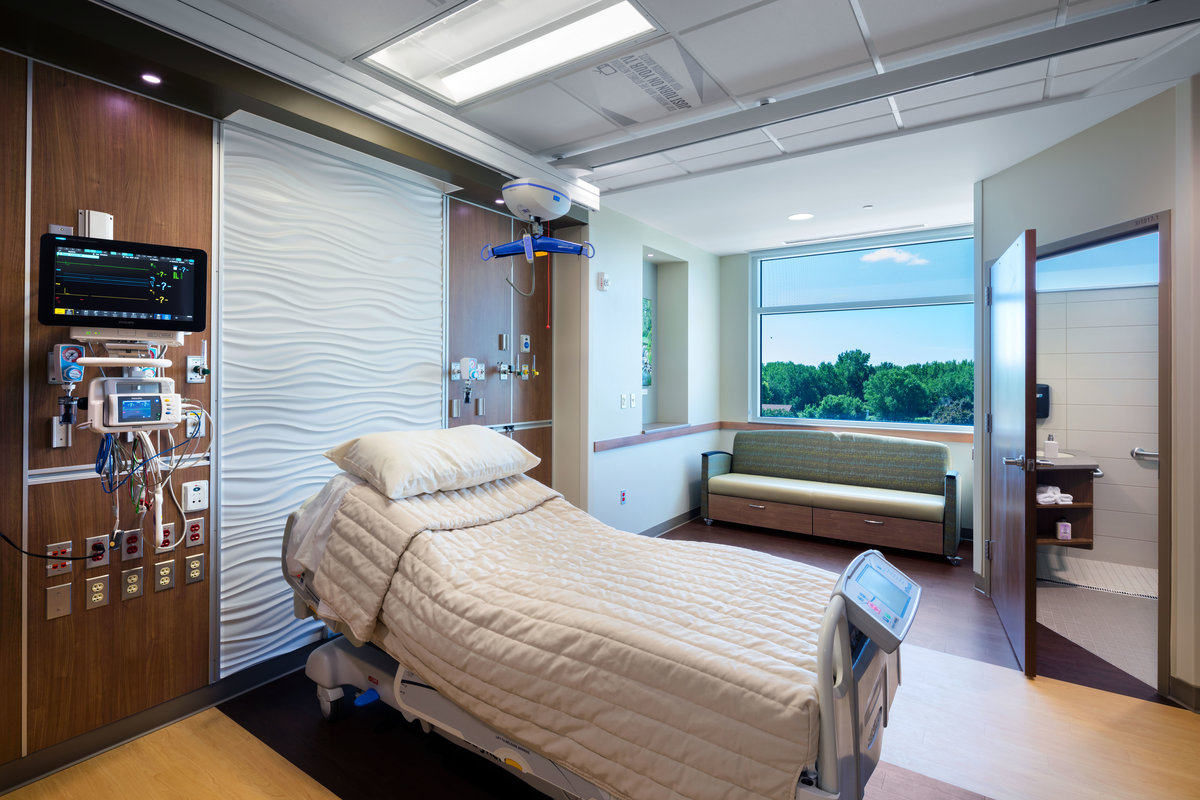HDR Architecture
Firm's role on the project: Planning, Programming, Architecture, Design, Interiors
EBD Goal
To provide an innovative, eco-friendly state-of-the-art facility focused on caring, quality healthcare. A key to the project’s success was establishing a shared vision and guiding principles and using those principles to guide decisions throughout the process. The principles included enhancing the patient experience, improving efficiency and safety, maximizing the project’s return on investment (ROI), and promoting a team environment to support a higher degree of patient and staff engagement.
Overview
With HDR’s creative vision “to create a sophisticated space with subtle regional influences,” the Great Plains Health (GPH) patient tower addition in North Platte, NE focuses on the physical and emotional well-being of patients and their families, as well as that of caregivers and staff. Using evidence-based design (EBD) concepts, the facility is designed to offer a tranquil experience for visitors from the time they enter and throughout their visit.
Challenge
HDR was challenged to integrate the latest evidence, data, and Lean operational strategies into the five-story patient tower design within the budget. Because the client was shifting operations from a centralized to a decentralized care model, it was critical to go beyond design services and incorporate specialty consulting services. This included transition planning along with signage and wayfinding, to help ease the challenges of the transition. The goals of increasing staff efficiency and improving the patient experience were informed by existing evidence and incorporated specific EBD strategies.

Solution
In the beginning, the client was concerned about patient units increasing in size and the impact on day-to-day operations. An HDR staff travel study demonstrated that even though the footprint was increasing, the decentralized design meant that walking distances would not increase. Mockup patient rooms were built and tested prior to construction to ensure the decisions made were functional and efficient. More than 40 changes to the mockup rooms translated to a more flexible design that also created cost savings during construction.
The design team and client toured other facilities that were using design strategies proposed by HDR. The client was able to see those applications in action and understand the implications for their own operations.
User-group meetings and community visioning sessions also influenced planning and design. The hospital design included community gathering spaces, and HDR and GPH sought input from community members throughout the design process. The team also gathered input on the bed tower design from regional representatives, comprised of administrators and doctors in surrounding communities.
EBD strategies included in the final design are:
-
Views of nature
-
Exposure to natural light
-
Decentralized nurse stations
-
Improved placement and number of hand-washing sinks
-
Large, single-bed, standardized, same-handed, conversion-ready patient rooms
Results
Data was collected in the existing facility using “Time Study RN,” a PDA handheld-based study with data compiled from nursing staff. The PDA alerts the nurses at random intervals to indicate their location, what task they just completed, and what task they are currently completing. This was used to track clinical behaviors, including value-added and nonvalue-added time. Results were compared to national benchmarking standards, and design strategies were implemented to increase value-added care activities.
The design team hypothesized that building acuity-adaptable patient rooms and moving from a centralized to a decentralized care model would improve staff efficiency and engagement. The next steps include a post-occupancy evaluation (POE) to measure how well the building is supporting employees’ needs. HDR also will conduct a study of the decentralized nursing model to study the impact of the change on nurses’ communication and satisfaction and on patient outcomes. A similar hospital site will be used to compare outcomes from both the POE and decentralized nursing study.

